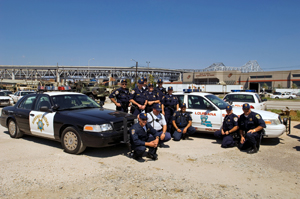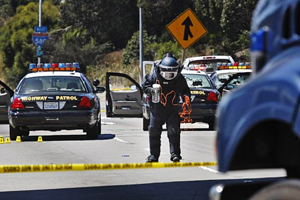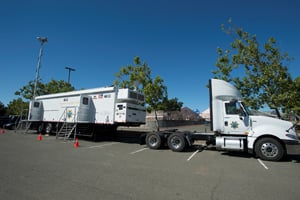Protective Services Division
Protective Services Division (PSD) is one of the most unique operational Divisions within the CHP. PSD is comprised of five commands, which include the Capitol Protection Section; Counterterrorism and Threat Awareness Section; Dignitary Protection Section; Emergency Operations and Safety Services Section; and Judicial Protection Section.
These sections are responsible for the protection of the Governor, constitutional officers, and dignitaries and judges. Other responsibilities include identifying and interdicting terrorist activity and providing vital law enforcement services for the State Capitol, state employees, state facilities, and state agencies located throughout the state.
Protective Services Division is located at 601 N. 7th Street Sacramento, CA 95811.
State Threat Assessment Center
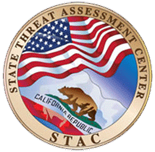
State Threat Assessment Center (STAC) is the centerpiece of the state's Information Sharing Environment (ISE). The STAC provides for the state's ability to maintain situational awareness over its broad threat domains in an effort to provide the highest level of safety, service, and security and prevent threats against its citizens and California infrastructure. The STAC provides strategic intelligence analysis to statewide leadership, policy makers, and private sector partners. The STAC focuses on terrorist and extremist threats to the public, critical infrastructure and key resources, as well as criminal threats to the public welfare from drug trafficking organizations, human traffickers, and street gangs.
Regional Threat Assessment Center (RTAC)
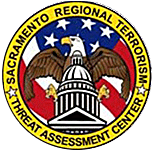
There are four RTACs located within California - Sacramento, San Francisco, Los Angeles, and San Diego. Their areas of responsibility mirror those of the four FBI Field Offices within the state; minimizing reporting conflicts, providing statewide coverage, and facilitating coordination with the FBI. RTACs are managed and staffed by local law enforcement, fire service, and other public safety agencies that maintain close, cooperative, coordinated, and mutually supportive working relationships with each other, the FBI Joint Terrorism Task Force (JTTF), and the STAC.
Counterterrorism and Threat Awareness (CTTA) Section

The CTTA has officers assigned to FBI Joint Terrorism Task Forces, the Emergency Notification and Tactical Alert Center, and the Terrorism Liaison Officer Program. The Counterterrorism and Threat Awareness Section's mission is to support CHP's homeland security efforts to:
-
Prevent and disrupt terrorist attacks within California
-
Protect the people of California and the state's critical infrastructure and key resources.
-
Respond to and recover from incidents that occur anywhere in the state.
Federal Bureau of Investigation Joint Terrorism Task Force (JTTF). Counterterrorism and Threat Awareness Section has officers assigned to JTTFs within the FBI Sacramento, San Francisco, Los Angeles, and San Diego Field offices. These officers are assigned to international terrorism, domestic terrorism, and operational threat squads that "triage" tips and leads from law enforcement contacts or civilian complaints. JTTFs are composed of federal, state, and local law enforcement officers for the purpose of identifying and disrupting potential terrorist plots by individuals or terrorist cells and sharing that information with law enforcement and intelligence partners. FBI JTTF INFORMATION
Emergency Notification and Tactical Alert Center
Emergency Notification and Tactical Alert Center (ENTAC). Acts as the Department's Operations Center (DOC) to coordinate the procurement of resources necessary to fulfill CHP responsibilities during emergency incidents. Involvement includes the coordination and supply of resources and/or exchange of intelligence or other information necessary to supplement Division Emergency Operation Centers in support of command and tactical operations at an emergency incident.
The role of the Department's Operations Center is to:
-
Provide support requested by field commands and incident commanders,
-
Serve as an information clearing center between Division Emergency Operation Centers (DEOCs), and,
-
Act as the liaison with allied agency representatives at the state level. In addition to DOC responsibilities, ENTAC is responsible for the following:
-
Act as the statewide coordinator for the AMBER Alert, Blue Alert, and Silver Alert programs and provide the public with immediate and up-to-date information about child abductions, wanted suspects, and missing adults via widespread media broadcast.
-
Provide statewide AMBER Alert, Blue Alert, and Silver Alert training for Department and allied agency personnel.
-
Administer the Suspicious Activity Reporting Program.
-
Provide notification to Executive Management for criteria met in General Order (G.O.) 100.80, Report of Unusual Occurences
Terrorism Liaison Officer (TLO) Program
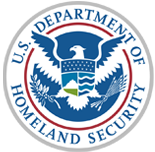
Counterterrorism and Threat Awareness Section operates a TLO program that assists the Department with information sharing by receiving and disseminating timely information to Department personnel. The TLO program also provides CHP personnel with counterterrorism related training and a regional and/or local point-of-contact for questions regarding terrorism related matters.
Emergency Operations and Safety Services Section (EOSS)
The Mission of the Emergency Operations and Safety Services Section (EOSS) is to support and enhance the CHP's ability to prevent, protect against, respond to, and recover from terrorist attacks, major disasters and other emergencies. EOSS is comprised of the Safety Services Unit (SSU) and the Emergency Management Unit (EMU).
Safety Services Unit. The mission of the SSU is to provide quality law enforcement service and security for state personnel and property. The SSU coordinates the statewide Safety Services Program (SSP) in accordance with California Vehicle Code §2400(g)(2015veh_code.pdf) and Government Code §14685(CA. Govt. Code), which establish guidelines for the protection of state employees, properties, and occupants of state-owned or state-leased facilities. Additionally, SSU, as part of the overall SSP, coordinates the following vital programs:
Workplace Violence Awareness and Prevention
|
What is Workplace Violence? |
|---|
|
Workplace Violence: Violence in which an individual knowingly and willfully inflicts or threatens to inflict, without legitimate purpose, serious harm, injury or death upon other persons, or damage to property, at the place of work. |
|
Violence: An extreme behavior intended to frighten, intimidate, injure, damage or destroy another person or property. Most often an expression of anger demonstrated by one or more of the following actions: inappropriate gestures, physical force, retaliation, self-prediction of loss of control, stalking, and/or overt threats. This list should by no means be considered |
|
Threat: A direct or implied expression of conduct intended to inflict physical harm, and/or actions which a reasonable person would perceive as a threat to their safety, the safety of others, or the safety of property. |
What am I required to do?
California Labor Code, §6401 - every employer shall do every other thing reasonably necessary to protect the life, safety, and health of employees. A STD. 99 form, Report of Crime/Incident on State Property Missing Lost Property shall be completed any time an act or threat of workplace violence is reported. California Code of Civil Procedure, §527.8 - any employer may seek a temporary restraining order, and an injunction on behalf of an employee who has been the victim of violence, or threat of violence in the workplace. Within 21 days, or if good cause appears to the court, 25 days from the date that a petition for a temporary order is granted or denied, a hearing shall be held on the petition for the injunction. If the requested injunction is issued it shall have a duration not to exceed three years. Under this Section, the plaintiff may apply for a renewal of the injunction up to three months before its expiration.
Can I receive support after a Workplace Violence incident?
-
Peer Support Personnel. Check with your agency supervisor for a list of employees. Peer Support Personnel are employees who have personal first-hand experience dealing with the It is the desire of the California Highway Patrol (CHP) to provide its employees with a workplace that is safe and healthful; this philosophy is directly supported by §6400 of the California Labor Code. To this end, violence or threat of violence in the workplace will not be tolerated in any form and the CHP has enacted a “Zero-Tolerance” workplace violence policy. Workplace Violence Prevention issues surrounding traumatic events. These employees volunteer their time to assist other employees with problems that may arise as a result of violence in the workplace.
-
Employee Assistance Program (EAP). The State of California provides access for all employees to EAP Counselors, who are specially trained and ready to deal with the most difficult of workplace related problems. EAP personnel are available to provide assistance 24 hours a day at (866) 327-0801 or eap4soc.mhn.com.
-
Support Group. Sometimes talking with others who have shared the same experience is helpful in the healing process. If this is the case, consider joining a local support group. (For more information contact your county social services office.)
-
Clergy. Local clergy can be called upon for just about anything; rarely will any compensation be expected. Most often, Pastors, Ministers, Priests and Rabbis have experience dealing with even the most horrible of situations. Members of the clergy generally receive specialized training to deal with a myriad of traumatic events.
Crime Prevention Program
|
Reporting Crimes on State Property |
|---|
|
Authority: Section 2400(g) of the California Vehicle Code gives the Commissioner of the California Highway Patrol (CHP) the authority and responsibility to develop a program to protect state employees. Section 14685(c)(1) of the Government Code authorizes the CHP to establish guidelines pertaining to the protection of state employees, properties, buildings, grounds, and occupants of state properties. |
|
Legal Requirements: Government Code Section 14613.7(a) requires state agencies to report to the California Highway Patrol all crimes on state-owned or state-leased property where state employees are discharging their duties. The CHP is then required to compile all information received and report to the state Legislature when requested. |
|
Purpose: The purpose of the CHP Crime Prevention and Security Program (CPS) is to assist in the prevention of criminal and terrorist threats against state employees and resources. The program helps ensure the protection of state assets against degradation or destruction that may affect the mission and capabilities of state resources and personnel. |
How to Report:
|
Crime/Incident On State Property : |
|
|---|---|
|
Step 1: |
Contact local CHP Office. |
|
Step 2: |
Complete STD. 99 form if crime/incident has occurred.Std99.pdf |
|
Step 3: |
Mail or call your local CHP office to have an officer pick up the completed STD.99 form. |
|
Lost/Stolen/Destroyed State Property: |
|
|---|---|
|
Step 1: |
Contact local CHP Office. |
|
Step 2: |
Complete STD. 152 form for lost/destroyed property. / STD.152 (PDF) |
|
Step 3: |
Contact CHP Emergency Notifications & Tactical Alert Center (ENTAC) if stolen property contains Information Technology (IT) information. Reference CHP 1040 & CHP 1041 forms for required reporting information.chp1040.pdf.chp1041.pdf |
|
Step 4: |
Mail or call your local CHP office to have an officer pick up the completed STD. 99 & STD. 152 forms. |
Elements of the Crime Prevention and Security Program:
-
Security Inspection. The Security Inspection (SI) is a self-assessment tool completed by the client state agency with the assistance, if requested, of CHP Area Safety Services Program (SSP) personnel. The SI is intended to provide an evaluation of a site’s existing crime prevention and site security capabilities. The SI is completed using the SI checklist contained in Highway Patrol Handbook (HPH) 100.2(HPH 100.2.pdf), State Agency Crime Prevention and Security Handbook. Other than basic facility information and remarks that may be entered on the inspection checklist, the SI does not include a narrative report or any formal written findings or recommendations.
-
Crime Prevention Plan. A Crime Prevention Plan (CPP) is designed to be completed following the completion of the SI. The CPP documents fundamental findings, recommendations, and goals to improve a facility’s crime prevention and security capabilities. A CPP is completed by the client state agency with the assistance of CHP Area SSP personnel, if requested, using the template and instructions provided in HPH 100.2.
-
Site Vulnerability Assessment (SVA) Memorandum. The SVA memorandum is completed by the Department and designed to compliment SI and CPP information through formal written documentation of findings and recommendations (options to consider). The SVA memorandum is only completed upon request from a state agency head and subsequent approval from CHP Protective Services Division (PSD).
-
Crime Prevention and Security Program Training. Upon request and availability, CHP Area SSP officers will provide CPS Program training to state agencies and employees to improve overall safety and security.
| How to complete a site vulnerability assessment: | |
|---|---|
|
Step 1: |
Contact local CHP Area Safety Services Program(SSP) personnel to obtain a copy of HPH 100.2. This Handbook provides the state agency representative user-friendly, step-by-step instructions for evaluating their facility. |
|
Step 2: |
Obtain training from local CHP Area SSP personnel on proper use of HPH 100.2. |
|
Step 3: |
Complete the SI checklist which begins on page 2 of HPH 100.2. When requested and available, Area SSP personnel will provide general guidance and assistance for conducting the SI. |
|
Step 4: |
Once the SI is completed, complete the CPP. The CPP instructions and template begin on page 12 of HPH 100.2. When requested and available, Area SSP personnel shall provide general guidance and assistance to facility managers developing the CCP. |
|
Step 5: |
Contact local CHP Area SSP personnel for further assistance or clarification. |
NOTE:
The SI and CPP are designed to be completed by a state facility representative with the assistance of a SSP officer from your local CHP office. However, when a state agency requests that CHP personnel complete the SI and CPP, the CHP Area commander will consider the size and scope of the assessment and a reimbursable services agreement may be considered prior to performing the requested service. If a facility manager believes a facility requires a more formal assessment and documentation, the manager might request that an SVA memorandum be completed. However, SVAs are not common; they are time consuming, costly, and are usually reserved for facilities considered to be critical infrastructure. Facilities qualifying for an SVA generally fall into one of the following three categories:
-
A mass population target (major amusement park, skyscraper, etc.).
-
A critical asset target (dams, water sources, etc.).
-
A target of symbolic significance (Golden Gate Bridge, Capitol, etc.)
In the event a client state agency still feels a facility requires an SVA, a request shall be made in writing by the state agency head and forwarded through channels to PSD for approval. Once an SVA request is received and approved by PSD, the Emergency Operations and Safety Services (EOSS) Section will coordinate with the affected Division to ensure an assessment of the appropriate level is completed.
Emergency Preparedness
Section 2400(g) of the California Vehicle Code gives the Commissioner of the California Highway Patrol (CHP) the authority and responsibility to develop a program to protect state employees. Section 14685(c)(1) of the Government Code authorizes the CHP to establish guidelines pertaining to the protection of state employees, properties, buildings and grounds, and occupants of state properties.
The mission of the Emergency Preparedness Program (EPP) is to protect state government officers and employees during emergencies. It also serves to prevent losses of state resources, other assets, and personal property as a result of emergency situations. The goal of the EPP is to assist state government by increasing awareness of the consequences of disasters. Beyond the recognition of these consequences, the objective is to prepare state employees to effectively respond to emergencies through measured, reasoned, and informed methods. The CHP EPP will accomplish this by:
-
Assisting state agency coordinators by providing a computer disk formatted with EPP information. State agency coordinators will then oversee the training of their employees.
-
Assisting in emergency preparedness plan development by making Highway Patrol Handbook (HPH) 100.3, California State Agency Emergency Action Plan, accessible to state agencies(Contact your local CHP office). This handbook provides state agencies a resource for guidance and direction in the creation of an Emergency Action Plan.
-
Providing pamphlets and brochures to assist in emergency preparedness planning.
-
Investigator Training Program
State Crimes Automated Reporting System (SCARS) -
Statewide Interagency Agreement Program
-
Tax Seizure Program
Workplace Safety Pamphlets
Emergency Operations Safeguard
Emergency Management Unit:
The mission of the EMU is to support and enhance the CHP's ability to prevent, protect against, respond to, and recover from terrorist attacks, major disasters and other emergencies. The following are EMU objectives:
-
Develop and enhance departmental policies and procedures relative to emergency incident management and homeland security related activities and operations.
-
Provide emergency incident and homeland security related training and coordinate departmental participation in emergency incident and homeland security related exercises.
